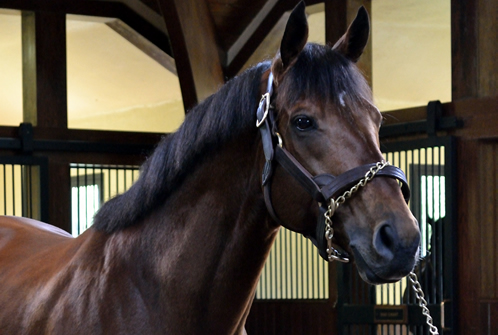Secretariat
One morning last week, Sherman, an impish 77 years old, leaned against a white-railed fence outside a horse barn at Pimlico Race Course. “That Secretariat, what a great horse he was,” he said. “I remember watching him run. All these years I’m thinking, I wonder if I’ll ever have a horse like that.” In the early morning light, Sherman shoved his hands a little deeper into the pockets of his green windbreaker, and looked over the top of his eyeglasses. “Well now,” he said, “maybe I do.” And then he smiled his little crooked smile, full of the impossible.

Big Brown at Three Chimneys in May 2012.
Looking back, it’s easy to see Big Brown’s loss in the 2008 Belmont Stakes as the point where the unraveling of IEAH began, and to marvel at how closely that outfit’s rise and fall paralleled the global subprime bubble and 2008 financial collapse, from slick talk and shady deals to ruin. Michael Iavarone and company boasted that they were bringing Wall Street to the racetrack, and in the worst way, they succeeded — all that’s left now of their ambitions, as Ryan Goldberg reports in his detailed, must-read story on Deadspin, is an empty equine hospital and a decrepit sign honoring Big Brown outside what was trainer Rick Dutrow’s Aqueduct barn. The horse, at least, is living the high life of a stud at Three Chimneys Farm, which has “all the charm of a quaint, leafy village, but with the perks of an executive suite” (via).
Turning to happier Belmont memories, what a remarkable moment:
We asked Chenery and Turcotte to watch the 1973 Belmont together. As the video played, as Chick Anderson’s legendary race call began, as the pair saw the timeless race unfold again, with Secretariat shooting up a gap near the rail, Turcotte told his former owner that he could feel the big horse’s heartbeat during the race, that he could feel the horse’s rhythmic breathing through his legs.
Hello Race Fans picks for Belmont day are up. Good luck, everyone!
In advance of a trip to Woodbine for next Sunday’s Pattison Canadian International Stakes, I’ve been reading up on the race’s history. It’s drawn globetrotters such as Dahlia; it’s been part of championship seasons like that of 1997 Breeders’ Cup Turf winner Chief Bearhart.
It was also Secretariat’s last start. That the Triple Crown winner ended his 21-race career at Woodbine, in Toronto, Ontario was a nice nod to racing history and the original Big Red — Man o’ War’s 21st, and final, start was a 1920 match race at Kenilworth Park in Windsor, Ontario, in which he defeated Sir Barton, the first-ever Triple Crown winner, by 17 lengths (there’s film).
According to the Thoroughbred Record’s account of the star’s appearance:
With a slightly different perspective, Secretariat’s arrival in Toronto six days before the Championship had overtones of the Threatre of the Absurd, with pockets of newsmen, photographers and television cameramen paying court to this four-footed millionaire from the sky. With Secretariat safely billeted in Barn 8 at Woodbine, looking out at the newly sodded surrounds, visitors were kept at bay by a nine-man security guard and signs which said: “Admittance by Appointment Only.” A telephone was installed ten feet from Secretariat’s stall … so that his handlers could use the phone without leaving the colt unattended, one was told. But, noticing the intelligent glint in Secretariat’s eye, one wondered.
“He can do everything but talk,” quipped Mr. Laurin…. “He’s a real ham.”
That he was also a real race horse was evident from his morning gallops, expending as little energy as possible in his preparation, and seemingly floating over the grass, balanced like a dancer.
To please trainer Lucien Laurin, the grass on Woodbine’s Marshall turf course was cut from approximately 4 1/2 inches in height to two inches, and parts of the course were patched with new sod and rolled. (“The course has never been better than it is right now,” said Woodbine tub thumper Bruce Walker.) Secretariat was obviously at ease on the surface: He worked five furlongs in :57 3/5 on the grass three days before the race, and skipped over the firm turf to win the International by 6 1/2 lengths, beating 11 others for a purse that totaled $142,700, the largest then ever offered in Canada. His $92,755 share of the purse brought his single-season earnings to a record $860,404. No other horse had ever won so much in one year.
In 1974, Dahlia — who had her own earnings record, as the first of her sex to win more than $1 million — set a new course record, running the International in 2:40, a full second faster than The Axe II had in the 1963 edition. The win was significant for another reason — it made Dahlia a stakes winner in five countries. Running and winning stakes around the world is still an exceptional accomplishment; 38 years ago, though, a 4-year-old filly with a career record that included wins in the International (Canada), Irish Oaks (Ireland), King George and Queen Elizabeth Stakes (England), Man o’ War Stakes (United States), and the Prix Saint-Alary (France) was a truly remarkable filly indeed.
– – – – –
This year’s Euro starters have begun to arrive for the Canadian International, as well as for the E.P. Taylor and Nearctic. Next Sunday’s races at Woodbine are the last three Breeders’ Cup Challenge races of 2012.
Copyright © 2000-2023 by Jessica Chapel. All rights reserved.